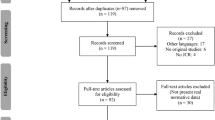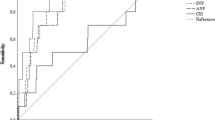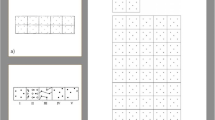Abstract
The phonemic/semantic alternate fluency test seems to overcome some limits of the instruments currently used to assess set-shifting abilities. In particular, this test does not make high demands on motor systems because the subject is required to rapidly change mental set to generate words by continuously alternating between phonemic and semantic criteria. Thus, it is potentially feasible for use in individuals who have movement disorders. In this regard, some data support its sensitivity in revealing cognitive impairments in people suffering from frontal–striatal-related disorders. The first aim of this study was to provide standardization and normative data for the phonemic/semantic alternate fluency test. The second aim was to upgrade normative data for the single phonemic and semantic fluency tests. For these purposes, we administered to a sample of 335 healthy Italian subjects (ranging from 20 to 90 years), a test consisting of the following three subtests: (1) a single letter-cued (phonemic) fluency subtest; (2) a single category-cued (semantic) subtest; (3) a phonemic/semantic alternate fluency subtest. A composite shifting index was also derived to capture the shifting cost a subject pays passing from performance of the two single fluency subtests to performance of the alternate fluency subtest. We computed correction grids to adjust raw scores for age, literacy and gender according to the results of regression analyses. Moreover, we computed equivalent scores to permit direct and fast comparison of performance on the three fluency tests.

Similar content being viewed by others
Notes
Software used to calculate tolerance limits is freely available at the following online address: http://www1.fpl.fs.fed.us/nonpar.html.
References
Miyake A, Friedman NP, Emerson MJ, Witzki AH, Howerter A (2000) The unity and diversity of executive functions and their contributions to complex ‘‘frontal lobe’’ tasks: a latent variable analysis. Cogn Psychol 41:49–100. doi:10.1006/cogp.1999.0734
Fisk JE, Sharp CA (2004) Age-related impairment in executive functioning: updating, inhibition, shifting and access. J Clin Exp Neuropsychol 26:874–890
McDaniel M, Einstein GO (2011) The neuropsychology of prospective memory and aging: a componential approach. Neuropsychologia 49:2147–2155. doi:10.1016/j.neuropsychologia.2010.12.029
Grossi D, Trojano L (2005) Neuropsicologia dei lobi frontali. Il Mulino, Bologna
Godefroy O, Azouvi P, Robert P, Roussel M, LeGall D, Meulemans T; Groupe de Réflexion sur l’Evaluation des Fonctions Exécutives Study Group (2010) Dysexecutive syndrome: diagnostic criteria and validation study. Ann Neurol 68:855–864. doi:10.1002/ana.22117
Lezak MD (2004) Neuropsychological assessment, IV edn. Oxford University Press, New York
Barletta Rodolfi C, Gasparini F, Ghidoni E (2011) Kit del neuropsicologo italiano. Dynamicon Edizioni, Milano
Downes JJ, Sharp HM, Costall BM, Sagar HJ, Howe J (1993) Alternating fluency in Parkinson’s disease. Brain 116:887–902
Henry JD, Crawford JR (2004) Verbal fluency deficits in Parkinson’s disease: a meta-analysis. J Int Neuropsychol Soc 10:608–622
Laiacona M, Inzaghi MG, De Tanti A, Capitani E (2000) Wisconsin card sorting test: a new global score, with Italian norms, and its relationship with the Weigl sorting test. Neurological Sci 21:279–291
Nocentini U, Di Vincenzo S, Panella M (2002) La valutazione delle funzioni esecutive nella pratica neuropsicologica; dal modified card sorting test al modified card sorting test-roma version dati di standardizzazione. Nuova Riv Neurol 12:13–24
Caffarra P, Vezzadini G, Dieci F, Zonato F, Venneri A (2004) Modified card sorting test: normative data. J Clin Exp Neuropsychol 26:246–250
Inzaghi MG (2010) Valutare le capacità di astrazione: il test di Weigl. Items, Giunti O.S, Firenze
Giovagnoli AR, Del Pesce M, Mascheroni S et al (1996) Trail making test: normative values from 287 normal adults controls. Ital J Neurol Sci 17:305–309
Amodio P, Wenin H, Del Piccolo F et al (2002) Variability of trail making test, symbol digit test and line trait test in normal people: a normative study taking into account age-dependent decline and sociobiological variables. Aging Clin Exp Res 14:117–131
Macdonald PA, Monchi O (2011) Differential effects of dopaminergic therapies on dorsal and ventral striatum in Parkinson’s disease: implications for cognitive function. Parkinsons Dis 6. doi:10.4061/2011/572743
Lee W, Williams DR, Storey E (2012) Cognitive testing in the diagnosis of parkinsonian disorders: a critical appraisal of the literature. Mov Disord 27:1243–1254. doi:10.1002/mds.25113
Amodio P, Campagna F, Olianas S, Iannizzi P, Mapelli D, Penzo M, Angeli P, Gatta A (2008) Detection of minimal hepatic encephalopathy: normalization and optimization of the psychometric hepatic encephalopathy score. A neuropsychological and quantified EEG study. J Hepatol 49:346–353
Nyhus E, Barceló F (2009) The Wisconsin card sorting test and the cognitive assessment of prefrontal executive functions: a critical update. Brain Cogn 71:437–451. doi:10.1016/j.bandc.2009.03.005.Epub2009Apr17
Jacobson SC, Blanchard M, Connolly CC, Cannon M, Garavan H (2011) An fMRI investigation of a novel analogue to the trail-making test. Brain Cogn 77:60–70. doi:10.1016/j.bandc.2011.06.001
Collette F, Hogge M, Salmon E, Van der Linden M (2006) Exploration of the neural substrates of executive functioning by functional neuroimaging. Neuroscience 139:209–221
Dirnberger G, Novak J, Nasel C, Zehnter M (2010) Separating coordinative and executive dysfunction in cerebellar patients during motor skill acquisition. Neuropsychologia 48:1200–1208. doi:10.1016/j.neuropsychologia.2009.12.016
Iudicello JE, Woods SP, Weber E, Dawson MS, Scott JC, Carey CL, Grant I, the HIV Neurobehavioral Research Center (HNRC) Group (2008) Cognitive mechanisms of switching in HIV-associated category fluency deficits. J Clin Exp Neuropsychol 30:797–804. doi:10.1080/13803390701779578
Zec RF, Belman J, Wainman S, McCool M, O’Connell C, Harris R, Robbs R, Elble R, Manyam B (1999) A comparison of phonemic, semantic, and alternating word fluency in Parkinson’s disease. Arch Clin Neuropsychol 14:255–264
Pagonabarraga J, Kulisevsky J, Llebaria G, García-Sánchez C, Pascual-Sedano B, Gironell A (2008) Parkinson’s disease-cognitive rating scale: a new cognitive scale specific for Parkinson’s disease. Mov Disord 23:998–1005. doi:10.1002/mds.22007
Mondini S, Mapelli D, Vestri A, Bisiacchi PS (2003) Esame Neuropsicologico Breve (ENB). Una batteria di test per lo screening neuropsicologico, Raffaello Cortina Editore
Spinnler H, Tognoni G (1987) Standardizzazione e taratura italiana di test neuropsicologici. Ital J Neurol Sci 6(Suppl 8):1–120
Boncori L (1991) Test: teoria e applicazioni. CRISP, Roma
American Psychiatric Association; Diagnostic and Statistical Manual of Mental Disorders 4th edn. text revision. American Psychiatric Association: Washington D.C. and London: 2000
Sheehan DV, Lecrubier Y, Sheehan KH, Amorim P, Janavs J, Weiller E, Hergueta T, Baker R, Dunbar GC (1998) The Mini-International Neuropsy-chiatric Interview (M.I.N.I.): the development and validation of a structured diagnostic psychiatric interview for DSM-IV and ICD-10. J Clin Psychiatry 59:22–33
Measso G, Cavarzeran F, Zappalà G, Lebowittz BD, Crook TH, Pirazzolo FJ, Amaducci LA, Massari D, Grigoletto F (1993) The Mini-mental state examination: normative study of an Italian random sample. Dev Neuropsychol 9:77–85
Magni E, Binetti G, Bianchetti A, Rozzini R, Trabucchi M (1996) Mini-Mental state examination: a normative study in Italian elderly population. Eur J Neurology 3:1–5
Carlesimo GA, Caltagirone C, Gainotti G, and the group for the standardization of the mental deterioration battery (1996) The Mental deterioration battery: normative data, diagnostic reliability and qualitative analyses of cognitive impairment. Eur Neurol 36:378–384
Novelli G, Papagno C, Capitani E, Laiacona M, Vallar G, Cappa SF (1986) Tre test clinici di ricerca e produzione lessicale: taratura su soggetti normali. Arch Psicol Neurol Psichiatr 4:477–506
Wilks SS (1941) Determination of sample sizes for setting tolerance limits. Ann Math Stat 12:91–96
Author information
Authors and Affiliations
Corresponding author
Rights and permissions
About this article
Cite this article
Costa, A., Bagoj, E., Monaco, M. et al. Standardization and normative data obtained in the Italian population for a new verbal fluency instrument, the phonemic/semantic alternate fluency test. Neurol Sci 35, 365–372 (2014). https://doi.org/10.1007/s10072-013-1520-8
Received:
Accepted:
Published:
Issue Date:
DOI: https://doi.org/10.1007/s10072-013-1520-8




